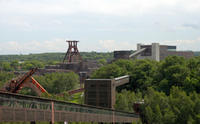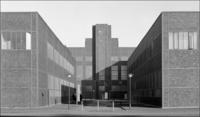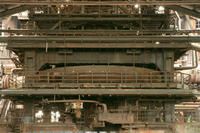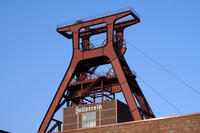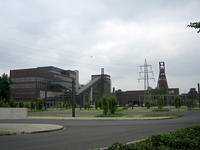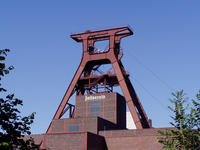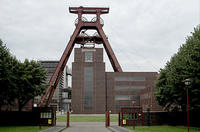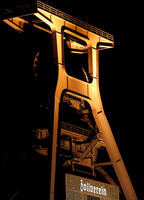You are in: Europe -> Germany -> Zollverein Coal Mine... , and traditional search or Image Gallery will yield results of this site only
Zollverein Coal Mine Industrial Complex in Essen
| Site number: | 975 |
|
| Type of site: | Cultural | |
| Date: | 20th-century | |
| Date of Inscription: | 2001 | |
| Location: | Europe, Germany, State of North Rhine-Westphalia (Nordrhein-Westfalen) | |
Up to 75 images are shown here. Click on each for more details or on Image Gallery for more images.
| Description: | The Zollverein industrial complex in Land Nordrhein-Westfalen encompasses the entire infrastructure of a historical coal-mining site, as well as various exceptional 20th-century buildings of architectural merit. The past 150 years of an essential industry’s evolution and decline are exposed through the site’s remarkable material evidence. --WHMNet paraphrase from the description at WHC Site, where additional information is available. | |
| The Zollverein Coal Mine Industrial Complex is a historical industrial monument in the city of Essen, North Rhine-Westphalia, Germany. It has been inscribed into the UNESCO list of World Heritage Sites since December 14, 2001 and is one of the anchor points of the European Route of Industrial Heritage. The first coal mine on the premises was founded in 1847, mining activities took place from 1851 until December 23, 1986. For decades starting in the late 1950s, the two parts of the site, Zollverein Coal Mine and Zollverein Coking Plant (erected 1957−1961, closed on June 30, 1993), were the largest of their kinds in Europe. Pit 12, built in Bauhaus style, was opened in 1932 and is considered an architectural and technical masterpiece and earned reputation as the “most beautiful coal mine in the world.” Zollverein Coal Mine was founded by Duisburg-born industrialist Franz Haniel (1779-1868), who had been seeking for coke for steel production. Test drillings in the Katernberg region (nowadays a suburb of Essen) had disclosed a very rich layer of coal, which was then named after the German Customs Union (Zollverein) founded in 1834. In 1847, Haniel founded the bergrechtliche Gewerkschaft Zollverein (a special kind of Prussian corporation for the exploitation of natural resources) and distributed the shares of the new company amongst the members of his family and the landowner of the to-be Zollverein territory. Sinking of pit 1 began on February 18, 1847, with the first mineral coal layer being found 130 meters under the surface. First mining activities took in 1851. Pit 2 (sunk simultaneously with pit 1) was opened in 1852. Both pits featured visually identical stone towers and shared a machine house. This concept was to be adapted by many later twin-pit coal mines. Starting in 1857, charcoal piles were used to produce coke. In 1866, the piles were replaced by a modern cokery and machine ovens. --Wikipedia. Text is available under the Creative Commons Attribution-ShareAlike License. | ||
| Source: | http://whc.unesco.org/en/list/975 | |
| Reference: | 1. UNESCO World Heritage Center, Site Page. | |





